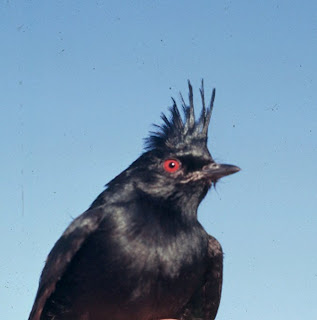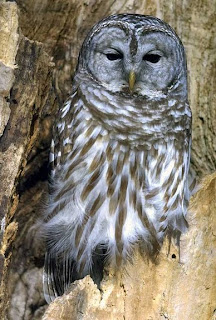Types of Learning
1. HABITUATION. This is the simplest type of learning-- learning not to respond to a stimulus that carries no reward or punishment. At first young turkeys crouch in response to anything moving overhead--older ones crouch at anything unfamiliar but pay no attention to things like falling leaves.
2. CONDITIONING. Learning to respond to stimuli that initially means nothing--like Pavlov's dogs who salavated when a bell was rung since it was rung every other time they were fed. We know little about conditioning in wild birds, but birds learn to associate feeders with food.
3. TRIAL AND ERROR. Young insectivorous birds will often peck at most anything but get better and better at finding insects and then learn to avoid noxious ones.
4. INSIGHT (INTELLIGENCE). An animal solves a problem without trial & error. Common Ravens can distinguish up to number six. This is about the same as people who are shown a number of objects without time to count.
5. IMPRINTING. Imprinting happens quickly and carries no immediate reward. Baby mallards will follow a person only between 13-16 hr.; it's impossible before 12 and after 24. (Try Googling Konrad Lorenz and geese.). Birds imprint on sexual partners; song, selection of habitat (?), home territory (?).
Returning to the subject of behavior, in general, there are two types of behavior, personal and social.
2. CONDITIONING. Learning to respond to stimuli that initially means nothing--like Pavlov's dogs who salavated when a bell was rung since it was rung every other time they were fed. We know little about conditioning in wild birds, but birds learn to associate feeders with food.
3. TRIAL AND ERROR. Young insectivorous birds will often peck at most anything but get better and better at finding insects and then learn to avoid noxious ones.
4. INSIGHT (INTELLIGENCE). An animal solves a problem without trial & error. Common Ravens can distinguish up to number six. This is about the same as people who are shown a number of objects without time to count.
5. IMPRINTING. Imprinting happens quickly and carries no immediate reward. Baby mallards will follow a person only between 13-16 hr.; it's impossible before 12 and after 24. (Try Googling Konrad Lorenz and geese.). Birds imprint on sexual partners; song, selection of habitat (?), home territory (?).
Returning to the subject of behavior, in general, there are two types of behavior, personal and social.
Phainopepla




Comments
Post a Comment